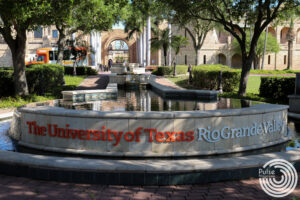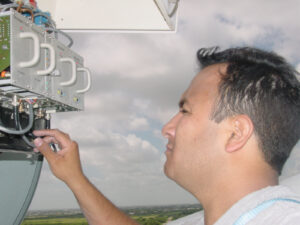Researching the language at the U.S.-Mexican Border
Professors from the University of Texas Rio Grande Valley and the University of Arizona received a grant to document the language spoken at the U.S.-Mexican border along the Rio Grande Valley and Southern Arizona. The goal is to engage the community by showing the developing corpora in the future.
A corpus, in linguistics, is “a collection of written texts, especially the entire works of a particular author of a body of writing on a particular subject,” according to Oxford Languages.
The project is called Bilingual Voices in the U.S.-Mexico Borderlands. Katherine Christoffersen, the project director, principal investigator, and an assistant professor at UTRGV; Ryan Bessett, co-principal investigator and an assistant professor at UTRGV; and Ana Carvalho, co-principal investigator and a professor at the University of Arizona, lead the project.
With the $60,000 Humanities Collections and References Resource grant, funded from the National Endowment for the Humanities (NEH), the project’s goal is to encourage more community-driven corpora. The Corpus Bilingüe del Valle (CoBiVa) and Corpus de Español del Sur de Arizona (CESA) websites were created to document the developing project.
Funds will be used to test various technologically aided transcription methods, such as the accuracy and speed of revising auto-generated transcripts, student participation, conferences, publications, webinars, and workshops, according to CoBiVa’s website.
Carvalho taught Christoffersen and Besset during their time working on their Ph.Ds at U of A. The three linguistic researchers submitted their proposal to NEH in July 2019. The team was notified of the award in April last year but received it in June 2020.
The team realized the need for funding the student-based corpus originated from not having funds to outsource their transcriptions. Although there are companies that specialize in looking at transcriptions, the students are trained with the technology to make the process “faster and easier.” Another reason for funding was to collaborate with the corpus in Arizona and get students involved in testing the transcription methods.
The creation of the corpus is made possible by the work of the contributing students in linguistic courses Christoffersen and Bessett teach. Christoffersen plans to teach an internship course in the Spring 2021 semester. The interns will conduct, transcribe and review interviews, and learn corpus development. Interns who serve as research assistants are paid from either the grant or the Engaged Scholar Award. This serves as student participation.
“We’re currently doing a three-week session of trials and we’re testing out three transcription methods: [Express Scribe], Microsoft Stream, and Speechnotes,” Christoffersen said.
To get the grant, the team submitted an 85–page proposal detailing and outlining the beta version of the project. Back in 2017, the team conducted interviews, developed the CoBiVa website, read through the NEH’s 30–page Notice of Funding, had the project approved by the Institutional Review Board in Spring 2018, held conversations with a program officer from NEH, created a timeline and a budget for it and coordinated with the libraries at both universities to have a memorandum of understanding.
There is extensive research on this area. Some of which intersect with topics such as Spanish as a heritage language and corpus development. The corpus being worked on falls under Sociolinguistics– the study of linguistic behavior as determined by sociocultural factors, according to Webster Dictionary.
“Language use symbolically represents fundamental dimensions of social behavior and human interaction,” said Walt Wolfram, an American sociolinguist at North Carolina State University, on the Linguistic Society of America’s “Sociolinguistics” webpage. “The notion is simple, but the ways in which language reflects behavior can often be complex and subtle. Furthermore, the relationship between language and society affects a wide range of encounters–from broadly based international relations to narrowly defined interpersonal relationships.”
Because of the project, Christofferson is able to create the corpus and teach corpus development in her classes. She asks students for feedback and reflections at the end of the semester. Many responses showed Christoffersen that her students developed an understanding of code-switching, which is the biggest reward for the professor. Bessett felt similar. He mentioned his students interviewed their relatives, noting one who interviewed her grandmother and learned more about her.
The project faced some issues, including the time taken to test transcription methods, changing how the CoBiVa website looked and deciding on spelling conventions and protocol for the corpus. The COVID-19 pandemic also brought its share of issues to the project. In Spring 2020, the professors planned for their students to conduct interviews; however, some took a while to complete them. Several students were able to complete them before the pandemic, and those who didn’t revised existing interviews.
“Fortunately, that’s been the roughest part,” Bessett said. “The majority of what we’ve been doing this summer has been working on transcriptions of interviews that we already have, and students work from their own house, using their computers. Going forward, it’s going to be a question of when can we start safely having students interview people in the community again. I think [that] will be our biggest hurdle.”
One of the goals for developing the corpus in the Rio Grande Valley is showing the “sophistication” of code-switching- the practice of shifting the languages one uses or the way one expresses themselves in conversations. The technique is perceived as people having less proficiency in a language; however, the opposite is correct. In some cases, this occurs when information is presented in another language, conversing with someone who is bilingual or when emphasizing something. It is more likely to happen when you know someone rather than meeting for the first time.
“We want to bridge the classroom with the community and with research,” Bessett said. “So, having students from our classes go in the community and talk to people, document language, that gets them working on actual linguistic research, which is exciting.”
The Bilingual Voices in the U.S.-Mexico Borderlands project led by Christoffersen, Bessett, and Carvalho is actively documenting the fluidity and flexibility that language has. From student accounts in Christoffersen and Bessett’s classes, they’ve heard the negativity instilled in using Spanish and English in a conversation. However, this information can possibly develop linguistic confidence within the people of the Rio Grande Valley and give further understanding about the rich linguistic characteristics of bilingualism in the Valley.








